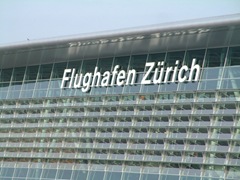
Prior Permission Required: you need one airport slot for your landing and one for your departure. Contact the Slot Management service of the airport by telephone +41 43 816 46 37 or per e-mail to slots.gasc@unique.ch. Getting a slot within the peak hours is not easy and even if you get one you can expect some delay. The airport policy is clearly to give priority to airline and commercial traffic. An accepted ATC flight plan is not considered as an airport slot nor a slot request.
Flight Plan Required: you also need an ATC flight plan. Even for national flights within Switzerland. Even for VFR. Even for VFR national flights within Switzerland. The good part of it is that Zurich Tower will automatically activate or terminate your flight plan.
Know Your Route: the airspace around Zurich is a bit complex. The TMA has different levels and if you come VFR you don’t want to bust into controlled airspace unexpectedly. The VFR reporting points are easy to spot but programming them in your GPS beforehand is not a bad idea. If you come IFR, expect own navigations or vectors along the arrival route. The number of SIDs is impressive but the system is easy to understand: there are a handful of exit fixes, and for each one there are RNAV and classical routes, for each of the six runways. This means 12 routes per exit fix.
[post-geocode zoom=”14″]
Taxi route: taxiing at large airports is sometimes the hardest part of the flight. The General Aviation Center is located south of threshold 28 and is organized in sectors. If you land on runway 14 you’ll have to cross runway 28/10 before reaching it, which implies working with Tower, Ground, Apron North and Apron South frequencies. Here again, good preparation is the key. Be ready for a clearance like “vacate runway via taxiway H1, taxi to runway 28 holding position J via taxiways H, J and B”. Don’t block the exit taxiway, controllers are always unhappy to give go-around clearances because the runway is blocked.
IFR specials – speed on final: all IFR traffic land on runway 14, so you will be integrated in the stream of landing airliners. Expect the typical “what will be your speed on final” question from the approach controller. Be sure not to promise something you can’t keep later on. I proposed once 160kts, which is possible in a PA32, but what I did not expected was the answer: “maintain 160kts to 2 miles final”. Oops, I was thinking of 160 to 4 miles. Hopefully the runway is plenty long and the taxiways are all at the end. Don’t forget to plan a long landing.
Wake turbulence: controllers are caring for good wake-turbulence separation between arriving and departing aircraft but a second check can be good. Check the time and point of rotation of departing aircraft until you get your line-up clearance and make sure that you have the necessary separation time. If it seems too short, don’t hesitate to delay your take-off, you don’t want to end-up in a wake-vortex.